
Israel controls 40% of Gaza City and will expand its operation in the coming days, an army spokesperson said on Thursday, as bombardments and ground advances forced more residents to flee while thousands chose to stay.
Gaza health authorities said at least 53 people were killed across the enclave on Thursday, mostly in Gaza City, where Israeli forces have pushed through outer districts and are now a few kilometres from the centre.
“We continue to damage Hamas’ infrastructure. Today we hold 40% of the territory of Gaza City,” Israeli military spokesperson Brigadier General Effie Defrin told a news conference, citing the Zeitoun and Sheikh Radwan neighbourhoods. “The operation will continue to expand and intensify in the coming days.” He said the campaign would end only once all remaining hostages are returned and Hamas’ rule is over.
Defrin also confirmed that army chief Eyal Zamir told cabinet ministers that, absent a post-war plan, Israel would need to impose military rule in Gaza. Far-right members of Prime Minister Benjamin Netanyahu’s coalition have urged such a step and the establishment of settlements there, ideas Netanyahu has so far rejected.
Israel launched the latest Gaza City offensive on Aug. 10, saying it aimed to defeat Hamas in areas that saw heavy fighting early in the war. The push has drawn international criticism over deteriorating humanitarian conditions and has stirred domestic unease in Israel amid reports of friction between some commanders and political leaders.
Residents reported strikes in Zeitoun, Sabra, Tuffah and Shejaia. Tanks moved into the eastern part of Sheikh Radwan, northwest of the city centre, demolishing homes and igniting fires in tent encampments, they said. In Tuffah, medics said eight people were killed and dozens wounded when several homes were hit.
“The Israeli occupation targeted a gathering of civilians and several homes in the Mashahra area of Tuffah — a fire belt that completely destroyed four buildings,” said Mahmoud Bassal, spokesperson for Gaza’s civil emergency service. “Even with warnings, there are no places left that can accommodate civilians.” The Israeli military had no immediate comment, saying it was operating on the city’s outskirts to dismantle tunnels and locate weapons.
Israel has again told civilians to leave Gaza City. It says about 70,000 have headed south; Palestinian officials say fewer than half that number have departed, leaving many thousands in the path of advancing troops. Aid groups warn that renewed displacement could be especially dangerous for children and other vulnerable people already weakened by hunger.
“This is going to be the most dangerous displacement since the war started,” said Amjad al-Shawa, head of the Palestinian NGOs Network, which coordinates with the U.N. and international agencies. Health officials in Gaza say 370 people, including 131 children, have died of malnutrition and starvation amid acute food shortages in recent weeks. Israel says it is taking steps to improve humanitarian conditions, including increasing aid flows.
The war began on Oct. 7, 2023, when gunmen led by Hamas killed around 1,200 people in southern Israel, mostly civilians, and took 251 hostages into Gaza. Israel’s subsequent offensive has killed more than 63,000 Palestinians, most of them civilians, according to local health authorities, and left much of the territory in ruins. Prospects for a ceasefire and a deal to free the remaining 48 hostages, of whom 20 are believed to be alive, appear dim.
After a visit to Gaza and the West Bank, U.S. Democratic Senators Chris Van Hollen and Jeff Merkley told reporters: “Based on our conversations and our observations, we came away with the inexplicable conclusion that the Netanyahu government is engaged in a campaign of ethnic cleansing in Gaza and slow-motion ethnic cleansing in the West Bank.”
